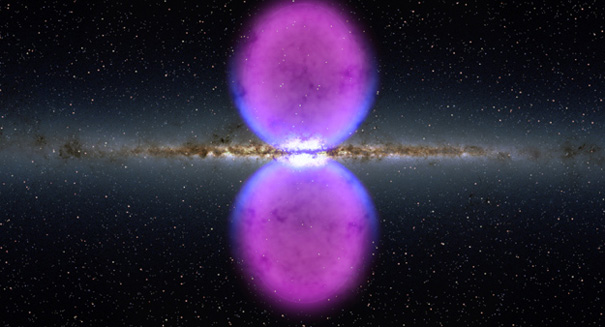
The measurement of gamma rays, the most energetic form of radiation, might help in understanding black holes say astronomers.
Ever heard of gravitational lensing? Me neither, but it sounds pretty cool and right now astronomers are making the very first gamma-ray measurement to figure out a sudden burst of light that came from a source 4 billion light-years away. The Astrophysical Journal Letters will feature the team’s paper describing the research in a future edition.
Gravitational lensing happens when a massive galaxy comes in between the source of light and the observer. Scientists generally conclude that gravitational lensing offers proof to further Einstein’s general theory of relativity, which explains how giant objects cause space and time to “curve.”
In September 2012, Fermi’s Large Area Telescope (LAT) found a series of bright gamma-ray flares from blazar B0218+357, which resides about 4.35 billion light-years from Earth. A blazar is a type of active galaxy that shows having strong, very intense emissions of electromagnetic radiation. According to Teddy Cheung, lead scientist of the study group and an astrophysicist at the Naval Research Laboratory in Washington, the deflector was an overriding spiral galaxy, which our Milky Way also is.
As a result of this “deflector,” light becomes distorted from what the star that produces with the initial light.
To better understand this phenomenon, Dr. Cheung and his team of astronomers looked at “three episodes of flares showing playback delays of 11.46 days.” These playbacks, they concluded, were results of gravitational lensing.
“One light path is slightly longer than the other, so when we detect flares in one image we can try to catch them days later when they replay in the other image,” said team member Jeff Scargle, an astrophysicist at NASA’s Ames Research Center in Moffett Field, Calif., in a press release.
Astronomers think that the gamma ray emissions followed slightly different paths. These diverging paths caused varying time delays as they travelled through space.
“Over the course of a day, one of these flares can brighten the blazar by 10 times in gamma rays but only 10 percent in visible light and radio, which tells us that the region emitting gamma rays is very small compared to those emitting at lower energies,” said Stefan Larsson, who was also part of the team and is an astrophysicist at Stockholm University in Sweden.
The scientists conclude that this study will help improve a better understanding of emission regions near black holes. They believe it will also help future measurements of other gravitational lens systems.
“It might also help us understand entirely new gravitational lens systems,” Cheung said.
Leave a Reply